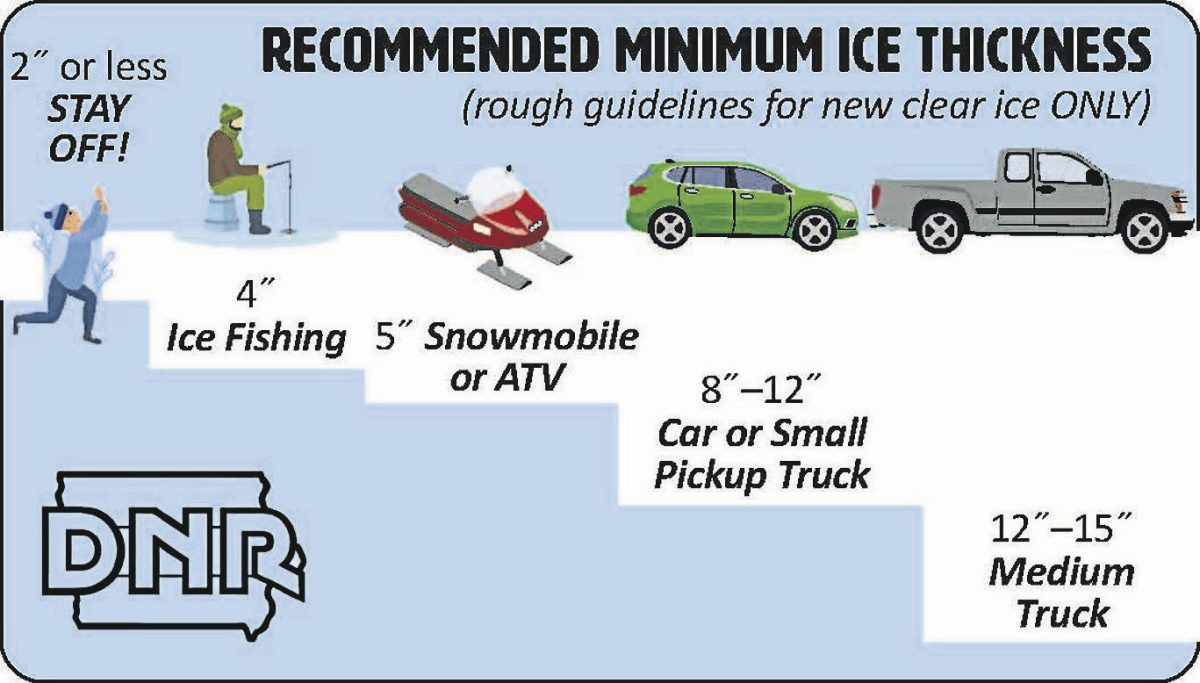The recent blast of arctic air kicking off January is growing ice on lakes and ponds over much of Iowa. Anglers are ready to get out for the popular early ice fishing season.
“Many of us can’t wait to get out on the ice each winter,” said Joe Larscheid, chief of fisheries for the Iowa Department of Natural Resources (DNR). “Ice fishing is a fun, inexpensive activity for anglers of all ages to get outdoors and avoid cabin fever.”
The DNR recommends a minimum of four inches of clear ice for fishing and at least five inches for snowmobiles and ATVs.
“Check ice thickness as you make your way to your favorite fishing spot,” Larscheid said. “Ice conditions change constantly and its thickness can vary across the lake. Trust your instincts – if the ice does not look right, don’t go out.”
A blanket of snow on top of an ice-covered lake insulates the ice, slowing the growth of ice and hiding potential hazards or weak spots. River ice is 15 percent weaker than lake ice. Ice with a bluish color is safer than clear ice. Avoid slushy or honey-combed ice and stay away from dark spots on the ice. Don’t walk into areas where the snow cover looks discolored.
Safety tips when fishing on the ice
• No ice is 100 percent safe.
• New ice is usually stronger than old ice.
• Don’t go out alone — if the worst should happen, someone will be there to call for help or to help rescue.
• Let someone know where you are going and when you will return.
• Check ice thickness as you go out — there could be pockets of thin ice or places where ice recently formed.
• Avoid off-colored snow or ice. It is usually a sign of weakness.
• The insulating effect of snow slows down the freezing process.
• Bring along these basic items to help keep you safe: hand warmers, ice cleats to help prevent falls, ice picks (wear around your neck) to help you crawl out of the water if you fall in, a life jacket, a floating safety rope, a whistle to call for help, a basic first aid kit and extra dry clothes including a pair of gloves.
Keep warm and dryDress in many thin layers of loose clothing. Start with a base layer that wicks perspiration away from your body and keeps warm air trapped there. Use a combination of natural and synthetic layers and make sure your outermost layer is windproof and waterproof. Always cover your head and hands. Wear warm socks (preferably wool) and insulated waterproof boots. Many anglers have portable ice fishing shelters to get out of the elements.
Equipment Necessities A five-gallon bucket has many uses – it can carry gear, works well as a seat, can haul your catch and can be used as an emergency floatation device if fall through the ice (turn the bucket upside down to trap air. You need a spud bar or ice auger (hand or gas powdered) to cut a hole (no larger than 10 inches) in the ice. Clear the hole of ice chips with an ice skimmer.
Ice fishing rods are usually short (18-24 inches long) and vary in stiffness depending on the type of fish you are pursuing. Some anglers build their own ice fishing rod from broken rods. Tip-ups are popular along the upper Mississippi River and on the Iowa Great Lakes to catch northern pike and walleye. The tip-up spans the ice hole and has a spool of line underwater. The spool is connected to a flag that is triggered to spring up when a fish takes the bait.
Electronic sonar units can help you locate where fish are hiding. Fish usually stay at a specific depth during the winter.
Think small and lightUse small hooks, small bait and light fishing line. Ice jigs are brightly colored (purple, chartreuse, pink, orange) to attract a fish’s attention and heavy enough to sink through the frigid water. Tungsten jigs have added weight that allows them to fall quicker and keep your fishing line tighter. Small metal jigging spoons are commonly used to catch walleye and crappie. You can drop your bait and leave it alone, or you can slowly jig to attract the fish. If you plan to fish for crappie after dark, you can use jigs that glow in the dark. Crappies often feed after sunset, so this is a good time to catch them.
Wax worms or wigglers (mayfly larvae) on a small teardrop lure is a great combination for catching bluegill or crappie. Store your wigglers in an insulated container kept next to your body to keep them from freezing. Small minnows are great for catching crappie, perch, yellow bass or walleye. Keep your minnows in an insulated bucket. Bring along a minnow dipper to keep your hands from getting wet.
What’s biting?
Most Iowa lakes are full of bluegills, which are the easiest and most often caught during the winter. Lakes in northern Iowa will have yellow perch and walleye in addition to bluegills. In southern Iowa, crappies join bluegills. Fish tend to be more active from dawn until mid-morning and late afternoon until sundown. Check the weekly DNR fishing report to find out what’s biting where, depths and areas of the lakes that are best and hot baits.
Look for structureUse the DNR’s online maps of the lake you are going to fish to find edges of creek channels, fish mounds, brush piles and rock piles that likely hold fish. Printable maps and the online Fishing Atlas are available.
Learn to use
spring bobbersFish are more lethargic, eat less often, and are less aggressive during the winter. Spring bobbers are made of very thin steel wire that attaches to your rod tip to help you see when you have a bite, often before you feel it on your line. Sponge slip bobbers can also be used to detect a bite and help you set the depth of your bait. They do not freeze easily and ice can be quickly removed by squeezing.
Stay safe as Iowa lakes freeze over, ice fishing season gets underway
January 13, 2022
SYSTEM
The Iowa Department of Natural Resources is reminding everyone of the appropriate thickness on ice needed for a range of hobbies this winter. Anything under two inches of thickness on the water is unsafe for a range of activities.

